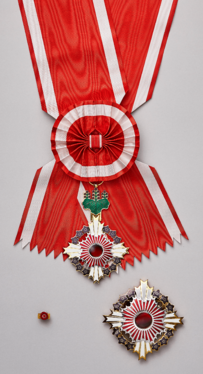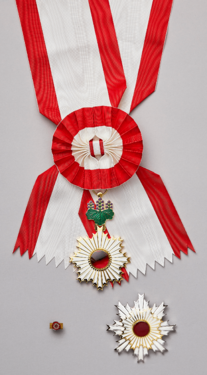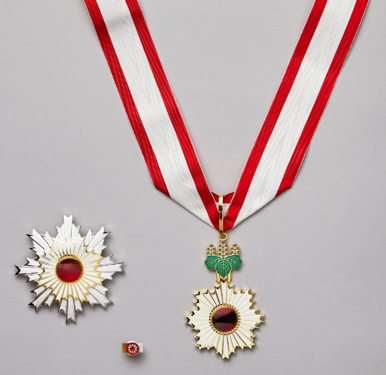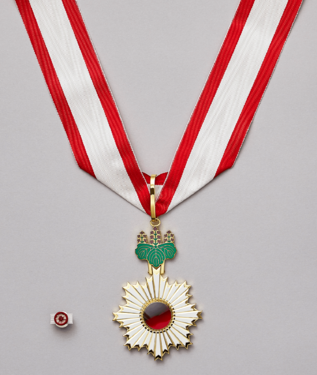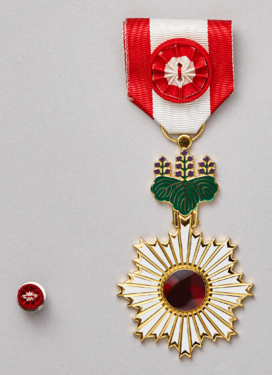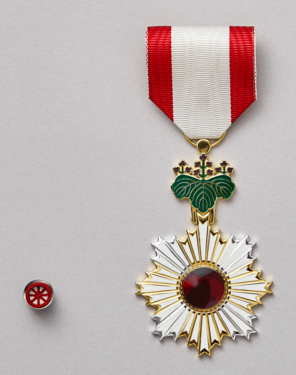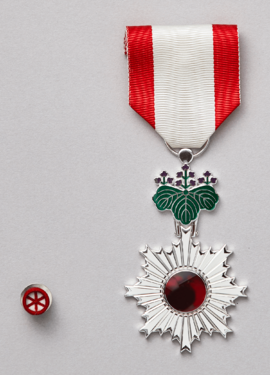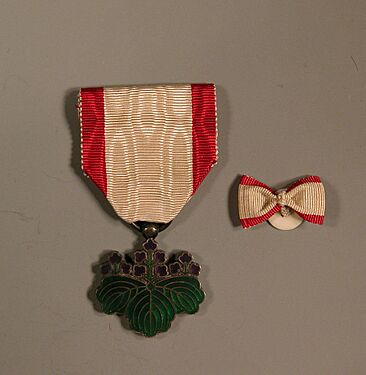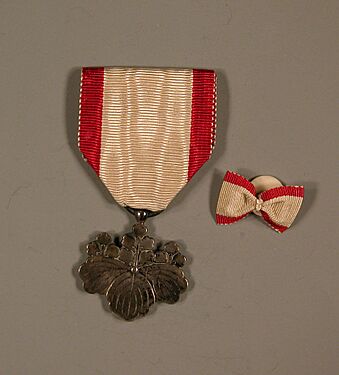Order of the Rising Sun facts for kids
Quick facts for kids Order of the Rising Sun旭日章 |
|
|---|---|
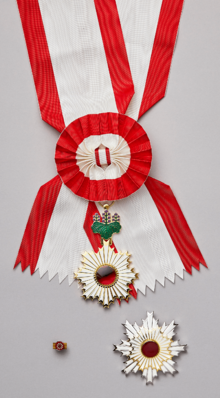
Grand Cordon of the Order of the Rising Sun (1st class)
|
|
| Awarded by the Emperor of Japan | |
| Type | Order |
| Founded | 10 April 1875 |
| Awarded for | Meritorious service to the state |
| Status | Currently constituted |
| Sovereign | HM The Emperor |
| Grades | 1st through 8th Class (1875–2003) Since 2003: Grand Cordon Gold and Silver Star (Rays, Principal Grade) Gold Rays with Neck Ribbon (Cordon, Middle Grade) Gold Rays with Rosette (Cordon, Junior Grade) Gold and Silver Rays (Double Rays) Silver Rays (Single Ray) |
| Precedence | |
| Next (higher) | Order of the Paulownia Flowers |
| Equivalent | Order of the Sacred Treasure Order of the Precious Crown |
The Order of the Rising Sun (旭日章, Kyokujitsu-shō) is a Japanese order, established in 1875 by Emperor Meiji. The Order was the first national decoration awarded by the Japanese government, created on 10 April 1875 by decree of the Council of State. The badge features rays of sunlight from the rising sun. The design of the Rising Sun symbolizes energy as powerful as the rising sun in parallel with the "rising sun" concept of Japan ("Land of the Rising Sun").
The Order of the Rising Sun is awarded to people who have rendered distinguished service to the state in various fields except military service. Since there is no order for military achievements under the current Japanese system, Japan Self-Defense Forces personnel are awarded the Order of the Sacred Treasure for their long engagement in public service. Prior to the end of World War II, it was also awarded for exemplary military service. In 2003, the 7th and 8th Class, which were at the bottom of the Order of the Rising Sun, were abolished, and the upper half of the 1st Class (勲一等, Kun-ittō) was separated as the Order of the Paulownia Flowers, which was higher than the Order of the Rising Sun.
Until 2003, the Order of the Rising Sun was on the same rank as the Order of the Precious Crown, with the Order of the Rising Sun being for men only and the Order of the Precious Crown for women only. The Order of the Sacred Treasure was treated as an order of slightly lower rank than the Order of the Rising Sun and the Order of the Precious Crown. For example, the 1st class of the Order of the Sacred Treasure was placed between the 1st class and the 2nd class of the Order of the Rising Sun and the Order of the Precious Crown, and the 2nd class of the Order of the Sacred Treasure was placed between the 2nd class and the 3rd class of the Order of the Rising Sun and the Order of the Precious Crown.
Since 2003, the Order of the Rising Sun has been awarded not only to men but also to women, and the Order of the Precious Crown has become a special order given only to female members of the imperial family in Japan and female members of royal families in foreign countries, only when it is specifically necessary for diplomatic ceremonies. The Order of the Rising Sun and the Order of the Sacred Treasure became the same rank of orders, and one of them came to be awarded because of the difference in the nature of the contribution to the state. The Order of the Rising Sun is awarded with an emphasis on achievements to the state, and the Order of the Sacred Treasure is awarded with an emphasis on long-term public service.
While it is the third highest order bestowed by the Japanese government, it is however generally the highest ordinarily conferred order. The highest Japanese order, the Order of the Chrysanthemum, is reserved for heads of state or royalty, while the second highest order, the Order of the Paulownia Flowers, is mostly reserved for politicians.
The modern version of this honour has been conferred on non-Japanese recipients beginning in 1981 (although several foreigners were given the honor before World War II). The awarding of the Order is administered by the Decoration Bureau of the Cabinet Office headed by the Japanese Prime Minister. It is awarded in the name of the Emperor and can be awarded posthumously.
Since 2003, the number representing rank included in the official name of the order was removed. As a result, although numbers representing ranks were sometimes used in common names, the formal names such as 勲一等 (Kun-ittō, First Class) and 勲二等 (Kun-nitō, Second Class) were no longer used.
Criteria for awarding
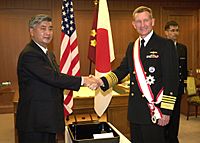
The Order of the Rising Sun is awarded to the following;
- A person who has contributed to the stability and development of the international community.
- A person who has contributed to the realization of appropriate tax payment.
- A person who has contributed to the promotion of school education or social education.
- A person who has contributed to the promotion of culture or sports.
- A person who has contributed to the promotion of science and technology.
- A person who has contributed to the improvement and promotion of social welfare.
- A person who has contributed to the improvement and promotion of the health or public health of citizens.
- A person who has contributed to the improvement of the working environment for workers.
- A person who has contributed to environmental conservation.
- A person who is engaged in the business of agriculture, forestry, fisheries, commerce, mining, industry, information and communications industry, construction industry, real estate industry, finance and insurance industry, service industry, etc., and has contributed to the public interest by developing the economy and industry.
- A person who has contributed to the public interest by engaging in the services of an attorney, certified public accountant, patent attorney, etc.
- A person who has contributed to the public interest by engaging in the work of newspapers, broadcasting or other news reporting.
- A person who has engaged in a public interest business such as Electricity Business, Gas Business, Transportation Business, etc. and has contributed to the promotion of public welfare.
- A person other than those listed in the preceding items who has contributed to the public interest.
Among them, regulations on the criteria for awarding orders to those who belong to the National Diet, the central and local governments, and courts stipulate in detail which ranks are awarded for each position. For example, the Grand Cordon of the Order of the Rising Sun (1st class) is awarded to a person who has made outstanding achievements in his/her position as Prime Minister, Speaker of the House of Representatives, President of the House of Councillors, or Chief Justice of Japan. The Grand Cordon of the Order of the Rising Sun (1st class) or the Order of the Rising Sun, Gold and Silver Rays (2nd class) are awarded to a person who has made outstanding achievements in his/her position as Minister of State, Deputy Chief Cabinet Secretary, Senior Vice-Minister, Vice Speaker of the House of Representatives, Vice President of the House of Councilors, or Judge of the Supreme Court.
Classes
The Order was awarded in nine classes until 2003, when the Grand Cordon with Paulownia Flowers was made a separate order, and the lowest two classes were abolished. Since then, it has been awarded in six classes. Conventionally, a diploma is prepared to accompany the insignia of the order, and in some rare instances, the personal signature of the Emperor will have been added. As an illustration of the wording of the text, a translation of a representative 1929 diploma says:
By the grace of Heaven, Emperor of Japan, seated on the throne occupied by the same dynasty from time immemorial,
We confer the Second Class of the Imperial Order of Meiji upon Henry Waters Taft, a citizen of the United States of America and a director of the Japan Society of New York, and invest him with the insignia of the same class of the Order of the Double Rays of the Rising Sun, in expression of the good will which we entertain towards him.
In witness whereof, we have hereunto set our hand and caused the Grand Seal of State to be affixed at the Imperial Palace, Tokyo, this thirteenth day of the fifth month of the fourth year of Shōwa, corresponding to the 2,589th year from the accession to the throne of Emperor Jimmu."
Insignia
The star for the Grand Cordon and Second Class is a silver star of eight points, each point having three alternating silver rays; the central emblem is identical to the badge. It is worn on the left chest for the Grand Cordon, on the right chest for the 2nd Class.
The badge for the Grand Cordon to Sixth Classes is an eight-pointed badge bearing a central red enamelled sun disc, with gilt points (1st–4th Classes), with four gilt and four silver points (5th Class), or with silver points (6th Class); each point comprises three white enamelled rays. It is suspended from three enamelled paulownia leaves (not chrysanthemum leaves as the Decoration Bureau page claims) on a ribbon in white with red border stripes, worn as a sash from the right shoulder for the Grand Cordon, as a necklet for the 2nd and 3rd Classes and on the left chest for the 4th to 6th Classes (with a rosette for the 4th Class).
The badge for the Seventh and Eighth Classes consisted of a silver medal in the shape of three paulownia leaves, enamelled for the 7th Class and plain for the 8th Class. Both were suspended on a ribbon, again in white with red border stripes, and worn on the left chest. Both classes were abolished in 2003 and replaced by the Order of the Paulownia Flowers, a single-class order that now ranks above the Order of the Rising Sun.
Notable recipients
1st Class, Grand Cordon
- Mustapa Mohamed (1950–), 2024
- Tony Abbott (1957–), Former Australian Prime Minister, 2022
- Creighton Abrams
- Aziz Abduhakimov, 2022
- Syed Hamid Albar, 2019
- Edmund Allenby, 1921
- James F. Amos, 2014
- Michael Armacost, 2007
- Richard Armitage, 2015
- Pridi Banomyong (1900–1983)
- Arthur Barrett, 1921
- Edmund Barton (1849–1920), Former Australian Prime Minister, 1905
- Carol Bellamy, 2006
- Felix von Bendemann, 1906
- Abdelmalek Benhabyles, 2012
- Charles Reed Bishop (1822–1915)
- Dennis C. Blair, 2001
- Sepp Blatter, 2009
- Gustave Emile Boissonade (1825–1910), 1909
- Walther von Brauchitsch (1881–1948), 1942
- Sydney Brenner (1927–2019), 2017
- Laurens Jan Brinkhorst, 2009
- Vincent K. Brooks 2018
- Arleigh Burke (1901–1996)
- Rudolf Burmester (1875–1956)
- Erwin Bälz (1849–1913), 1905
- George W. Casey Jr. 2010
- Krasae Chanawongse, 2004
- Dick Cheney, 2018
- Helen Clark, 2017
- James Wheeler Davidson (1872–1933), 1896
- Kemal Derviş, 2009
- Karl Dönitz, (1891–1980), 1943
- Malcolm Fraser, (1930–2015) Former Australian Prime Minister, 2006
- Jerome Isaac Friedman, 2016
- Bill Gates (1955–), Co-chair of the Bill & Melinda Gates Foundation, 2020
- Robert Gates, 2017
- Thamir Ghadhban, 2016
- Julia Gillard (1961–), Former Australian Prime Minister, 2021
- David L. Goldfein, 2021
- Sir Stephen Gomersall KCMG, 2015
- Ralph Gonsalves, 2024
- Hermann Göring (1893–1946)
- António Guterres, 2002
- William Hague, 2017
- Sri Sultan Hamengkubuwono IX (1912–1988), 1982
- Sir Edward Heath 1998
- Ginandjar Kartasasmita (1941–), 2008
- Jusuf Kalla (1942–), 2022
- Akbar Tandjung (1945–), 2022
- John Hamre, 2016
- Kenzaburo Hara (1907–2004), 1996
- Harry B. Harris Jr., 2018
- Dennis Hastert, 2010
- Bob Hawke (1929–2019), Former Australian Prime Minister, 2012
- Reinhard Heydrich (1904–1942), posthumous
- Musa Hitam, 2018
- Soichiro Honda (1906–1991), 1991
- John Howard (1939-), Former Australian Prime Minister, 2013
- Masaru Ibuka (1908–1997), 1997
- Daniel Inouye, 2000
- Henry Jackson (1855–1929)
- S. Jayakumar, 2012
- Karu Jayasuriya (1940–), 2016
- Anerood Jugnauth, 1988
- Henk Kamp, 2014
- Caroline Kennedy (1957–), 2021
- Abhakara Kiartivongse, 1900
- Thanom Kittikachorn
- Bert Koenders, 2014
- Komura Jutarō (1855–1911)
- Jorge Kosmas Sifaki, 2014
- Sir John Kotelawala (1895–1980), 1954
- V. Krishnamurthy, 2009
- Wataru Kubo, 2001
- Ashwani Kumar, 2017
- Lee Hsien Loong (1952–), 2016
- Lee Kuan Yew (1923–2015), 1967
- Curtis LeMay (1906–1990) 1964
- Queen Liliʻuokalani (1838–1917), 1882
- Wangari Maathai, 2009
- Ibrahim Mabrouk (1873–1959), 1934
- Douglas MacArthur (1880–1964), 1960
- Sir John Major, 2012
- Mike Mansfield, 1990
- Baron Yasutake Matsuoka, 1906
- Yōsuke Matsuoka, 1940
- John McCain, 2018
- John McEwen, 1973
- Franz-Michael Skjold Mellbin, 2011
- Robert Menzies (1894–1978), Former Australian Prime Minister, 1973
- Norman Yoshio Mineta (1931–2022), 2007
- Phumzile Mlambo-Ngcuka (1955–), 2022
- Amina C. Mohamed, 2017
- Mahathir Mohamad, 1991
- Ernest Moniz, 2017
- Ivan Mrkić, 2018
- Hendrik Pieter Nicolaas Muller (1859–1941)
- A. M. Nair, alias "Nair-San"
- Ben Ngubane, 2010
- Peter Pace, 2007
- Rear Admiral Ali Osman Pasha, 1890
- Andrew Peacock, Former Australian politician and diplomat, 2017
- Nancy Pelosi, 2015
- William J. Perry, 2002
- John J. Pershing, 1918
- Plaek Phibunsongkhram, 1942
- Józef Piłsudski, 1928
- Herbert Plumer (1857–1932)
- Ram Chandra Poudel, 2020
- Joachim von Ribbentrop (1893–1946), 1937
- Condoleezza Rice, 2017
- Edward A. Rice Jr.
- Jay Rockefeller, 2013
- Herman Van Rompuy, 2015
- Donald Rumsfeld, 2015
- Eishiro Saito, in 1992
- Saisho Atsushi, 1906
- Klaus Schwab, 2013
- Abid Sharifov, 2016
- Count Paul de Smet de Naeyer,
- Shoichiro Toyoda, 2002
- Chea Sim, 2013
- Dr. Manmohan Singh, 2014
- Edward Śmigły-Rydz, (1886–1941)
- Isamu Takeshita (1869–1949), 1920
- Strobe Talbott, 2016
- Ratan Tata, 2012
- Her Majesty Queen Te Atairangikaahu of New Zealand (1931–2006), 1970
- Tengku Ahmad Rithauddeen, 2018
- John Anthony Cecil Tilley (1869–1952)
- Tokugawa Yoshinobu (1837–1913), 1908
- Goh Chok Tong, 2011
- Matome Ugaki, ca. 1945.
- Cesar Virata, 2016
- Võ Hồng Phúc, 2012
- Wan Waithayakon
- Wang Jin-pyng (1957–), 2021
- Sir John Whitehead GCMG CVO (1932–2013), 2006
- Gough Whitlam, 2006
- Yi Kang, 1912
- Yusuf Abdul Rahim, 1985
2nd Class, Gold and Silver Star
- Mohammad Hossein Adeli (1953–), 2014
- Salem Ben Nasser Al-Ismaily, 2017
- Momofuku Ando (1910–2007), 2002
- Jaime Zóbel de Ayala (1934–), 2018
- Zeti Akhtar Aziz (1947–), 2017
- Sri Sultan Hamengkubuwano X (1946–), 2022
- Arden L. Bement, Jr. (1932–), 2009
- Jagdish Bhagwati (1934–), 2006
- Henryka Bochniarz(1947–), 2010
- Louis Bols (1867–1930), 1921
- Gustave Emile Boissonade (1825–1910), 1876
- Donald Prentice Booth (1902–1993), 1961
- Georges Hilaire Bousquet (1846–1937), 1898
- Jules Brunet (1838–1911)
- Rash Behari Bose (1886–1945)
- Horace Capron (1804–1885), 1884
- Chang Yung-fa (1927–2016), 2012
- Rita R. Colwell (1934–), 2005
- William Douglas Crowder, 2008
- Gerald Curtis, 2005
- Marzuki Darusman, 2017
- Sir Joseph Dimsdale (1849–1902), 1902
- Kiin Donarudo, 1993
- Jonathan M. Dorfan (1947–), 2017
- Hugh Elles (1880–1945)
- José Manuel Entrecanales, 2018
- Predrag Filipov, 2019
- Bill Frenzel, 2000
- Kuntoro Mangkusubroto (1947–), 2023
- Thamir Ghadhban (1945–), 2016
- Thomas Blake Glover (1838–1911), 1908
- Richard N. Haass (1951– ), 2023
- William Reginald Hall (1870–1943)
- Lionel Halsey (1872–1946)
- Mazie Hirono (1947– ), 2021
- Ho Mei-yueh (1951– ), 2021
- Kazuo Ishiguro (1954- ), 2018
- Mohamed Nouri Jouini, (2019)
- Arifin Tasrif (1953–), 2023
- Onkar Singh Kanwar (1942–), 2018
- Donald Keene (1922–2019), 1973
- Michael Kirby, 2017
- Michał Kleiber, 2012
- David C. Knapp, (1927–2010)
- Tommy Koh, 2009
- Jeffrey Koo, 2012
- George Trumbull Ladd (1842–1921)
- Cecil Lambert (1864–1928)
- Dan Larhammar (1956–), 2022
- Tsung-Dao Lee 2007
- Charles LeGendre (1830–1899), 1874
- Wassily Leontief (1905–1999), 1985
- Lilia B. de Lima, 2006
- Yusron Ihza Mahendra (1958–), 2022
- Abdul Gafoor Mahmud(1934-), 2017
- William Flynn Martin, 2018
- William R. Merz, 2021
- Ignasius Jonan (1963–), 2022
- Connie Morella (1931–), 2016
- Riccardo Muti, 2016
- Thottuvelil Krishna Pillai Ayappan Nair 2015
- Hideyo Noguchi (1876–1928), 1928
- George R. Packard 2007
- Jerzy Pomianowski
- Randles, Sir John Scurrah (1875–1945)
- Chintamani Nagesa Ramachandra Rao, 2015
- Rein Raud, 2011
- Governor J. Peter Ricketts, 2022
- Johannis de Rijke (1842–1913)
- Wilbur L. Ross (1937–), 2015
- Vsevolod Rudnev (1855–1913), 1907
- Saisho Atsushi, 1887
- Shyam Saran, 2019
- Jacob Schiff (1847–1920), 1907
- William Francis Sempill (1893–1965)
- N. K. Singh (2016)
- Jouko Skinnari, 2011
- E. Sreedharan (1932–), 2013
- Wendell M. Stanley (1904–1971), 1966
- Michael Ira Sovern 2003
- Sayidiman Suryohadiprojo (1927–2021), 2012
- Washington SyCip, 2017
- Henry W. Taft (1859–1945), 1929
- Frederick Charles Tudor Tudor (1863–1946)
- Charles Vaughan-Lee (1867–1928)
- John Waldron (1909–1975) 1971
- Bryon Wilfert (1952–), 2011
- Ernst-Ludwig Winnacker (1941–), 2009
- Richard J. Wood, 2010
- Kenkichi Yabashi (1869–1927), 1927
- Philip Yeo (1946–), 2007
- Lim Jock Seng, 2013
- Hamdillah Abdul Wahab, 2013
- Nor Jeludin, 2020
- Badr bin Saud al Busaidi, 2021
- Lim Jock Hoi, 2024
3rd Class, Gold Rays with Neck Ribbon
- Craig Agena (1960–), 2014
- John F. Aiso (1909–1987), 1985
- Giorgio Amitrano (1957–), 2020 (ceremony held in 2022)
- James E. Auer, 2009
- William Hansel Barrow (1936–2020), 2005
- William Sturgis Bigelow (1850–1926), 1909
- Edmund Blunden (1896–1974), 1963
- Ivan Bondarenko, 2012
- Richard Bowring (1947–), 2013
- Ben Nighthorse Campbell (1933–), 2011
- Kent E. Calder, 2014
- Ion Caramitru, 2017
- Kirsti Koch Christensen, 2006
- Albert Diamond Cohen, 2011
- Jennifer Corbett, 2014
- Edwin Cranston, 2009
- Rust Macpherson Deming, 2013
- Steven DeMoss, 2022
- Rudy Demotte, 2016
- Michael Donnelly, 2014
- Ronald P. Dore
- Todd A. Dozier, 2021
- Peter Drysdale, 2001
- Clint Eastwood, 2009
- Gustave Eiffel (1832–1923)
- Stanisław Filipek, 2006
- Jack Fujimoto, 2011
- Robert Garfias, 2005
- Carol Gluck, 2006
- William Elliot Griffis (1843–1928), 1926
- Mahdi Elmandjra, 1986
- Moto Hagio, 2022
- Percival Hall-Thompson (1874–1950)
- Jochem P. Hanse, 2007
- Helen Hardacre, 2018
- James Curtis Hepburn (1815–1911)
- Judit Hidasi, 2005
- Yanosuke Hirai (1902–1986), 1972
- Irene Hirano (1948–2020), 2020
- John Charles Hoad (1856–1911), 1906
- Susumu Honjo, 2003
- Jiro Horikoshi (1903–1982), 1973
- Bill Hosokawa (1915–2007), 1987
- John Howes, (1924–2017), 2003
- Robert Huey, 2019
- Romuald Huszcza, 2012
- José Luis Ceacero Inguanzo, 1886
- Keiichi Ishizaka (1945–2016), 2015
- Muhammad Nurul Islam (1943–), 2012
- Jean-François Jarrige (1940–2014)
- Kanō Jigorō (1860–1938)
- Peter Jost (1921–2016), 2011
- Otto Hermann Kahn (1867–1934)
- Kusuma Karunaratne (1940–)
- Stephen Ira Katz, 2012
- Dr. Nghiem Vu Khai, 2014
- Harue Kitamura, 2004
- Paul Joseph Koessler, 2018[1]
- Larry Kominz, 2022
- George Koshi c. 1960
- George Trumbull Ladd (1842–1921)
- Miles Wedderburn Lampson (1880–1964)
- Kuo-Hsiung Lee, 2011
- Yves Leterme, 2016
- Carlos Rubio López de la Llave, 2014
- Norman Macrae (1923–2010), 1988
- Paul Magnette, 2016
- William P. Malm, 2020
- Mike Masaoka, 1968
- Matthew H. Molloy, 2013
- Kyuzo Mifune (1883–1965), 1964
- John Milne (1850–1913)
- Earl Miner (1926–2004)
- Edwin McClellan (1925–2009), 1998
- Seang Nam, 2020
- Edward Gage Nelson, 2008
- Ian Nish, 1991
- Setsuko Matsunaga Nishi, 2009
- Dr. Susumu Nisizaki, 2018
- Jerzy Nowacki, 2008
- John O'Conor, 2011
- Peter O'Malley, 2015
- Dennis M. Ogawa, 2016
- Taiichi Ohno, 1982
- Janusz Onyszkiewicz, 2019
- Piotr Paleczny, 2019
- Henry Spencer Palmer (1838–1893), 1887
- T.J. Pempel, 2022
- Susan Pharr, 2008
- Umberto Pineschi, 2009
- Lee Poh Ping, 2010
- John Powles, 2008
- Pyle, Kenneth B. 1999
- John Mark Ramseyer, 2018
- Sadia Rashid, 2019
- Dzulkifli Abdul Razak, 2019
- Nguyễn Chí Vịnh, 2021 (Awarded in 2023)
- Jacob Raz, 2006
- Rustum Roy, 2002
- David Rowe-Beddoe, 2008
- David Russell, 2010
- Raaj Kumar Sah, 2017
- Emiko "Emily" Sano, 2008
- Wolfgang Sauerwein (1952–), 2020
- Isaac Shapiro (1931–), 2006
- David Bowman Schneder, 1936
- Edward Seidensticker, 1975
- Go Seigen aka Wu Qing Yuan (1914–2014), 1987
- John Stich, 2021
- William Forbes-Sempill
- Shinichi Suzuki (1898–1998), c. 1970
- Jeanette Takamura, 2009
- George Tanabe, Jr., 2013
- Ichimatsu Tanaka (1895–1983), 1967
- Tadao Tannaka (1908–1986), 1980
- Patrick Lennox Tierney, 2007
- Royall Tyler, 2008
- István Ujszászy (1894–1948), 1942
- Joseph K.H. Uy, 1991
- T. Wayland Vaughan (1870–1952), 1940
- Rudi Vervoort, 2016
- Andrzej Wajda, 1995
- Doi Michio, 1915
- Paul Watanabe, 2017
- Willy Vande Walle, 2006
- Sam Walsh, 2021
- R.J. Zwi Werblowsky, 2009
- Charles Wolf, Jr, 2007
- Lydia Yu-Jose, 2012
- Jan van Zanen, 2016
- Abul Barkat (1954–), 2022
4th Class, Gold Rays with Rosette
- Hank Aaron (1934–2021), 2016
- Ferran Adrià (1952–), 2015
- Toshiko Akiyoshi (1929–), 2004
- Syed Feroz Alam Shah, 2020
- Boris Akunin (1956–), 2009
- Arvydas Ališauskas, 2012
- Shusaku Arakawa (1936–2010), 2010
- Martha Argerich (1941–), 2005
- Charles Aznavour (1924–2018), 2018
- Kazuhiko Bandoh, 2014
- Andrej Bekeš, 2008
- Ilana Singer Blaine (b. 1961), 2021
- Henry Pike Bowie (1848–1920), 1909
- James R. Brandon, 1994
- William Penn Brooks, 1888
- Bobby Charlton, 2012
- Tim Clark (historian of Japanese art), 2020
- Willard G. Clark (1930–2015), 1991
- David Cope, 2012
- Clyde Everett Dickey (1934–), 2010
- Charles B. Doleac, Esq., 2011
- Bogna Barbara Dziechciaruk-Maj, 2009
- William Elliot Griffis (1843–1928), 1907
- Kenji Ekuan (1925–2015), 2000
- Atsuko Toko Fish 2018
- Fujiko Fujio A (1934–), 2008
- Glen Gondo, 2013
- Ted Goossen, 2018
- Mohammad Hatta (1902–1980), 1943
- Reiko Hayama (1933–), 2011
- Steven Heine (1950–), 2007
- Asao Hirano (1926–2019), 2001
- Terumasa Hino (1942–), 2019
- Joe Hisaishi, 2023
- Michael Arnold Hodgkin, 2019
- William Imbrie (1845–1928), 1909
- Iskandar Jalil, 2015
- Randall Sidney Jones, 2015
- Rena Kanokogi (1935–2009), 2008
- Gō Katō (1938–2018), 2008
- Kihachirō Kawamoto (1925–2010), 1995
- George Kerr (1937–), 2010
- Keisuke Kinoshita (1912–1998), 1984
- Joy Kogawa (1935–), 2010
- Sachi Koto (1951– ), 2021
- Włodzimierz Kwieciński (1955–), 2012
- Tommy Lasorda (1927–2021), 2008
- Liao I-chiu (1936–), 2014
- Charles Von Loewenfeldt, 1987
- Alfred Majewicz, 2002
- Leiji Matsumoto, 2010
- Hazel McCallion, 2014
- Rokusaburo Michiba, 2007
- Frank A. Miller, 1929
- Nobuko Miyamoto, 2022
- Shiro Floyd Mori, 2012
- Raymond Moriyama (1929–2023), 2003
- Kent Nagano, 2008
- Masaya Nakamura (1925–2017), 2007
- Olivia Newton-John (1948–2022), 2021
- Hideyo Noguchi (1876–1928), 1915
- Krystyna Okazaki, 2007
- David Ono, 2022
- Ivica Osim, 2016
- Daniel Ost, 2015
- Kenneth Oye, 2018
- Edwina Palmer, 2018
- Takao Saito, 2010
- Ian Michael Scher, 2021
- David Bowman Schneder, 1917
- Frederik L. Schodt, 2009
- Peter Schreier, 2019
- Manmohan Singh, 2007
- George Shima (1864–1926)
- Terry Shima (1923–), 2013
- Tatsuzo Shimaoka (1919–2007), 1999
- Setsuko Shinoda (1955–), 2020
- Joseph Bower Siddall (1840–1904), 1909
- Dragan Stojković (1965–), 2015
- Sukarno (1901–1970), 1943
- Koichi Sugiyama (1931–2021), 2018
- Hiroshi Tachi (1950–), 2020
- George Takei (1937–), 2004
- Takeo Okuno (1926–1997), 1997
- Brian Taniguchi (1951–), 2023
- Kip Tokuda (1946–2013), 2012
- Masanobu Tsuji (1902–1961), 1942
- George Tsutakawa (1910–1997), 1981
- Morihei Ueshiba (1883–1969), 1964
- Raymond S. Uno, 2014
- H. Paul Varley (1931–2015), 1966
- The Ventures, 2010
- Sadao Watanabe (1933–), 2005
- Tetsuya Watari (1941–2020), 2013
- William Scott Wilson (1944–), 2015
- Teruaki Yamagishi (1934–), 2008
5th Class, Gold and Silver Rays
- Grant Masashi Ujifusa (1942–), 2012
- Mary-Grace Browning MBE (1944–), 2016
- Miyazaki Atsuo (1947–), 2021
- Dick Beyer (1930–2019), 2017
- Vytautas Dumčius, 2016
- Douglas Erber, 2021
- Dr. Rupert Faulkner (Victoria & Albert Museum), 2020
- Shyamala Ganesh, 2021
- George Geddie (1869–1961), 1907
- Toshihiro Hamano, 2017
- Frances Hashimoto (1943–2012), 2012
- Takami Hibiya (1909–1993) 1981
- Rino Wicaksono, 2021 https://www.liputan6.com/global/read/4701141/dosen-indonesia-rino-wicaksono-raih-gelar-the-order-of-the-rising-sun-dari-jepang
- Abdullah Ibrahim (1934– ), 2020.
- Jan Kowalewski (1892–1965), 1923
- Kira Liscutín Córdova de Abreu (?–), 2021
- Glenn Masuo Masunaga (1925–2019), 1999
- Lori Matsukawa (1956– ), 2022
- Br. Jude McKenna OFM Cap (1935– ), 2019.
- Soleiman Mehdizadeh (1955– ), 2012
- Kenzo Mori (1914–2007), 2007
- Shōshin Nagamine (1907–1997), 1982
- Roy Masahiro Nagata, 2005
- Shūgorō Nakazato (1920–2016), 2007
- Kiyoshi Nishiyama (1893–1983), 1977
- Steere Noda, 1968
- Jun Noguchi, 2011
- Hironori Ōtsuka (1892–1982), 1966
- Sumitra Peries (1934–2023), 2021
- Vincenzo Ragusa (1841–1927), 1884
- Major Douglas Estment Randall, MC (1891–1926), 1925
- Antone Rosa (1855–1898), 1884
- Inés Sánchez (1931– ), 2012
- Buster Sefor (1941–), 2011* Low Thian Seng, 2015
- Garrett Serikawa (1932–2019), 2016
- Doreen Simmons (1932–2018), 2017
- Yosihiko H. Sinoto (1924–2017), 1995
- Alfred Russell Stone (1902–1954), 1954
- James Takemori (1926–2015), 2004
- Seiichi Tanaka (1968– ), 2013
- Alicia Terada, 2017
- Rudolf Teusler (1876–1934)
- Ted Tsukiyama (1920–2019), 2001
- Ronald Stewart Watt (1947– ), 2010
- William Wheeler (1851–1932), 1924
- Shuji Yagi (Shuho Bon Yagi), 2019
- Akira Yoshizawa (1911–2005), 1983
- Branislav Crnogorac (1952–), 2020
6th Class, Silver Rays
- Fadi Aoun / Lebanon (2022)
- Henry Hajimu Fujii (1886–1976), 1971
- Kuniichi Iwata (Specialist) (1919–2014), 1995
- Bolesław Orliński (1899–1992), 1926
- Fudeko Reekie, 2013
- Shigetaka Sasaki (1903–1993), 1986
- John Wilson (Captain) (1851–1899), 1895
- Yun Chi-sung (1875–1936), 1905
7th Class, Green Paulownia Leaves Medal
In 2003, the 7th and 8th levels – named for leaves of the Paulownia tree, long used as a mon (emblem) for the highest levels of Japanese society – were moved to a new and distinct order, the single-class Order of the Paulownia Flowers.
- Leonard Kubiak (1899–1939), 1926
- Shōjiro Kuwazoe (1876–1953)https://www.familysearch.org/tree/person/memories/LYXL-XXQ
8th Class, white Paulownia Leaves Medal
In 2003, the 7th and 8th levels – named for leaves of the Paulownia tree, long used as a mon (emblem) for the highest levels of Japanese society – were moved to a new and distinct order, the single-class Order of the Paulownia Flowers.
Class unknown
- Aung San (1915–1947)
- Beneš, Edvard (1884–1948), 1928
- Ralph T. Browning (1941–2018)
- Burzagli, Ernesto (1873–1944), 1906
- Henry Clews (Awarded 1908)
- Craig, Albert M. (1988)
- de Bary, William Theodore (1993)
- Eichelberger, Robert Lawrence (1886–1961)
- Ellis, Alfred John (1915–2020), 1989
- Fortescue, Granville Roland (1875–1952)
- Gibney, Frank B. (1924–2006), 1976
- Józef Gieysztor
- Grondijs, Louis (1878–1961)
- Hosoya, Judayu (1840–1907)
- Ibrahim, Sultan of Johor (1873–1959)
- Knott, Cargill G. (1856–1922), 1891
- Wiesław Kotański, 1986
- Kunz, George Frederick (1856–1932)
- Charles de Limburg Stirum (1906–1989)
- Henryk Lipszyc, 1992
- McKenzie, Lionel W. (1995)
- Morrison, George F. (1867–1943)
- Musa Ghiatuddin Riayat Shah, Sultan of Selangor (1893–1955)
- Ozaki Yukio (1858–1954)
- Paine, Godfrey (1871–1932), 1918
- Patrick, Hugh Talbot 1994
- Raymond, Rossiter W. (1840–1918)
- Takamine Hideo (1854–1910)
- Wasson, James R. (1847–1923), 1874
- Franciszek Ziejka
- Ivan Ivanovich Zarubin (1822–1902), 1881
- Jane Birkin (1947–2023), 2018
See also
 In Spanish: Orden del Sol Naciente para niños
In Spanish: Orden del Sol Naciente para niños
- Order of merit: A list of orders by various states
- Systems of other states:
- Order of Civil Merit (Korea)
- Order of Chula Chom Klao and Order of the White Elephant (Thailand)
- Order of St. Michael and St. George (UK)
- Legion of Honour (France)
- Order of Merit of the Federal Republic of Germany (Grand Merit Cross, Merit Cross and Merit Medal equivalents)
- Order "For Merit to the Fatherland" (Russia)
- Order of Isabella the Catholic (Spain)
- Order of Merit of the Italian Republic
- Decoration of Honour for Services to the Republic of Austria (Grand Decoration in Gold with Sash, in Gold with Star, in Gold, Grand Decoration of Honour, Decoration of Honour in Gold, Decoration of Merit in Gold)
- Order of Prince Henry (Portugal)


